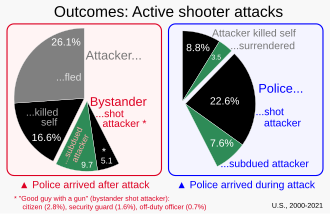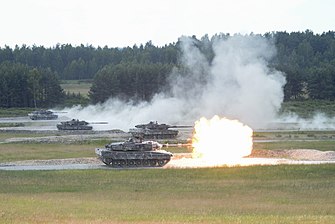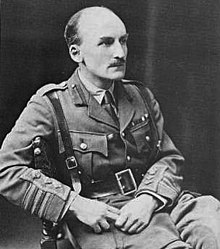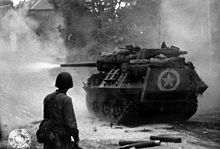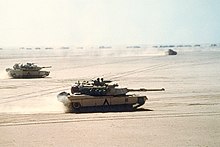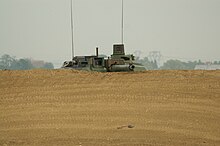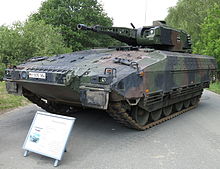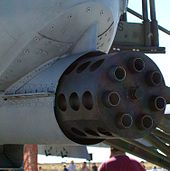From Wikipedia, the free encyclopedia
https://en.wikipedia.org/wiki/Armoured_warfare
Armoured warfare or armored warfare (American English; see spelling differences), is the use of armored fighting vehicles in modern warfare. It is a major component of modern methods of war. The premise of armoured warfare rests on the ability of troops to penetrate conventional defensive lines through use of manoeuvre by armoured units.
Much of the application of armoured warfare depends on the use of tanks and related vehicles used by other supporting arms such as infantry fighting vehicles, self-propelled artillery, and other combat vehicles, as well as mounted combat engineers and other support units. The doctrine of armoured warfare was developed to break the static nature of World War I trench warfare on the Western Front, and return to the 19th century school of thought that advocated manoeuvre and decisive battle outcomes in military strategy.
World War I
Modern armoured warfare began during the First World War of 1914–1918. Strategists wanted to break the tactical, operational and strategic stalemates forced on commanders on the Western Front by the effectiveness of entrenched defensive infantry armed with machine guns—known as trench warfare.
Under these conditions, attacks usually advanced very slowly and
incurred massive casualties. The developers of tanks aimed to return
manoeuvre to warfare, and found a practical way to do so: providing
caterpillar traction to machine guns allowing them to overcome trenches,
while at the same time offering them armour protection against small-arms (pistol, rifle, and machine gun) fire as they were moving.
British heavy tank of World War I
Britain and France first developed tanks in 1915 as a way of navigating the barbed wire and other obstacles of no-man's land while remaining protected from machine-gun fire. British Mark I tanks first went into action at the Somme on 15 September 1916, but did not manage to break the deadlock of trench warfare. The first French employment of tanks, on 16 April 1917, using the Schneider CA, also failed to live up to expectations. In the Battle of Cambrai (1917) (November to December 1917) British tanks were more successful, and broke a German trenchline system, the Hindenburg Line.
Despite the generally unpromising beginnings, the military and
political leadership in both Britain and France during 1917 backed large
investment into armoured-vehicle production. This led to a sharp
increase in the number of available tanks for 1918. The German Empire, on the contrary, produced only a few tanks, late in the war. Twenty German A7V
tanks were produced during the entire conflict, compared to over 4,400
French and over 2,500 British tanks of various kinds. Nonetheless, World
War I saw the first tank-versus-tank battle, during the Second Battle of Villers-Bretonneux in April 1918, when a group of three German A7V tanks engaged a group of three British Mark IV tanks which they met accidentally.
After the final German spring offensives of 21 March to 18 July 1918, the Entente deployed tanks en masse at the Battle of Soissons (18 to 22 July 1918) and Battle of Amiens (August 1918), which ended the stalemate imposed by trench warfare on the Western Front, and thus effectively ended the war.
Tactically, deployment plans for armour during the war typically
placed a strong emphasis on direct support for infantry. The tank's main
tasks were seen
as crushing barbed-wire and destroying machine-gun nests, facilitating
the advance of foot soldiers. Theoretical debate largely focused on the
question of whether to use a "swarm" of light tanks for this, or a
limited number of potent heavy vehicles. Though in the Battle of Cambrai
a large concentration of British heavy tanks effected a breakthrough,
it was not exploited by armour. The manoeuvrability of the tank should
at least in theory regain armies the ability to flank
enemy lines. In practice, tank warfare during most of World War I was
hampered by the technical immaturity of the new weapon system, limiting
speed, operational range, and reliability, and a lack of effective
armoured tactics.
Strategic use of tanks developed only slowly during and
immediately after World War I, partly due to these technical limits but
also due to the prestige role traditionally accorded to horse-mounted
cavalry. An exception, on paper, was the Plan 1919 of the British Army's Colonel John Fuller,
who envisaged using the expected vast increase in armour production
during 1919 to execute deep strategic penetrations by mechanised forces
consisting of tanks and infantry carried by lorries, supported by
aeroplanes, to paralyse the enemy command-structure.
Following the First World War, the technical and doctrinal
aspects of armoured warfare became more sophisticated and diverged into
multiple schools of doctrinal thought.
Interwar period
1920s
During the 1920s, a very limited number of tanks were produced. There
were however, important theoretical and technical developments. Various
British and French commanders who had contributed to the origin of the
tank, such as Jean Baptiste Eugène Estienne, B. H. Liddell Hart and J. F. C. Fuller,
theorised about a possible future use of independent armoured forces,
containing a large concentration of tanks, to execute deep strategic
penetrations. Especially Liddell Hart wrote many books about the
subject, partly propagating Fuller's theories. Such doctrines were faced
with the reality that during the 1920s the armoured vehicles, as early road transport
in general, were extremely unreliable, and could not be used in
sustained operations. Mainstream thought on the subject was more
conservative and tried to integrate armoured vehicles into the existing
infantry and cavalry organisation and tactics.
Technical development initially focussed on the improvement of
the suspension system, transmission and engine, to create vehicles that
were faster, more reliable and had a better range than their WW I
predecessors.
To save weight, such designs had thin armour plating and this inspired
fitting small-calibre high-velocity guns in turrets, giving tanks a good
antitank capacity.
Both France and Britain eventually built specialised infantry tanks,
more heavily armoured to provide infantry support, and cavalry tanks
that were faster and could exploit a breakthrough, seeking to bring
about defeat of the enemy by severing his lines of communication and
supply, as cavalry had done during the previous century.
The British were the first to create a larger fully mechanised unit when the War Office sanctioned the creation of the Experimental Mechanised Force,
which was formed on 1 May 1927, under infantry Colonel R. J. Collins,
after Fuller (was) refused the function. Its sub-units were entirely
mobile and consisted of reconnaissance tankettes and armoured cars, a battalion of forty-eight Vickers Medium Mark I
tanks, a motorised machine-gun battalion, a mechanised artillery
regiment, which had one battery of fully tracked self-propelled Birch guns capable of acting as conventional or anti-aircraft artillery, and a motorised company of field engineers. The unit carried out operations on Salisbury Plain and was observed by the other major nations, the United States, Germany, and the Soviet Union. Although its performance was recognised, it was disbanded in 1928.
All major European states (with the exception of Germany that was forbidden to possess armoured vehicles under the Treaty of Versailles),
the US, and Japan, would create their own experimental mechanised
forces during the late 1920s, many using either French or British
vehicle designs or even directly purchased vehicles, but largely
borrowing from both to develop their own doctrines.
1930s

During the 1930s, political tensions between the world powers quickly increased. The Soviet Union
and France began to rearm in the early thirties. In the Soviet Union,
the mechanisation of the armed forces was part of a massive general
industrialisation programme, the successive Five Years Plans,
and the country soon had more tanks than the rest of the world
combined, thousands of them being produced per year. In this period,
before the rise to power of the Nazi Party in Germany, German officers
were sent to observe and participate in development of armoured doctrine
in the USSR. Red Army
and German experts collaborated in developing the use of tanks based on
second generation vehicles with turreted main weapons, and
experimenting to design different chassis configurations and drive
trains. One important acquisition for the Red Army turned out to be the
purchase of a T3 chassis, using the Christie suspension, from US designer John Walter Christie, which served as the basis of the Soviet BT series of fast tanks. The Red Army tactics were influenced by the theoretical works of Marshal Mikhail Tukhachevsky who advocated "large scale tank warfare" as part of the deep battle doctrine.
In France, the second largest tank producer, mechanisation was
motivated by a need to compensate for severe manpower shortages due to a
collapsed birth rate during World War I. This led to the development of
a vast range of specialised armoured vehicles, not just tanks but also armoured cars, self-propelled guns, mechanised artillery, armoured tractors, armoured supply vehicles, armoured artillery observation vehicles, armoured command vehicles, half-tracks, and fully tracked armoured personnel carriers.
As the mechanisation progressed, slowly the French armour doctrine
began to reflect the increased capacity, evolving from direct infantry
support, to independent breakthrough and eventually envelopment with the
Infantry, and to deep strategic exploitation with the Cavalry.
Despite the increase in tank numbers, in all countries financial
constraints prohibited a full mechanisation of the entire armed ground
forces. Necessarily, most of the divisions still consisted of infantry
that was not even motorised. As a result, tanks tended to be allotted to
special armoured units, where the limited and expensive expert
maintenance and training capacity could be concentrated. Only the Soviet
Union had enough tanks to equip an organic tank battalion in each
infantry division. Nevertheless, France was the first to create large
armoured units: in 1934 two Mechanised Corps were formed of 430 tanks
each. In July 1935, in France the 4th Cavalry Division was transformed into the 1e Division Légère Mécanique, the first French armoured division of the Cavalry. In Germany, after the Nazi Regime started open rearmament in March 1935, on 15 October 1935 three Panzerdivisionen
were formed. Though some tank brigades were part of the Cavalry or
Infantry arm, most German tanks were concentrated into a special branch,
from 1936 called the Panzerwaffe.
The precise interpretation of this phenomenon has proven controversial
among military historians. Traditionally, it has been seen as part of a "Blitzkrieg strategy" of swift world conquest by means of armoured forces. Later it has been argued, among others by Karl-Heinz Frieser, that the German army in the 1930s did not even possess an explicit Blitzkrieg
tactical doctrine, let alone strategy. This would have been reflected
by the relatively unimpressive rate of tank production and development. During the 1930s the United Kingdom gave priority to the Royal Air Force and Royal Navy. The British Army began the conversion of its cavalry from horse to tanks and all but a few regiments were fully converted by 1939. The British First Armoured Division was formed, as the "Mobile Division", in November 1937.
Before the Second World War actual use of armoured fighting vehicles was limited. Both sides used Italian, German and Soviet tanks during the Spanish Civil War
but these proved to be vulnerable to antitank guns due to their thin
armour. Traditionalist elements within the Red Army used this to
diminish the influence of proponents of mechanisation. Tukhachevsky himself was executed in 1937. Nevertheless, during the Soviet-Japanese Border Wars of 1938 and 1939, the Soviet forces tested modern armoured warfare tactics. General Georgy Zhukov in the summer of 1939 combined mass tank manoeuvres with artillery and air attacks, to defeat the Japanese Imperial Army at the Battles of Khalkhin Gol at Nomonhan in Mongolia.
Partly as a result of the experiences in Spain, the Soviet Union began
the development of a new generation of medium and heavy tanks, sporting
much stronger armour and armament.
World War II
Poland
In their Invasion of Poland during September 1939, German forces applied a narrow cooperation between large armoured units — of the Panzerwaffe
and the Cavalry — and "active" infantry divisions to break the Polish
defensive lines and pursue the defeated enemy forces. The more limited
and dispersed Polish armoured units were quickly destroyed. The Red
Army, invading the east of Poland, also deployed armoured divisions. At the time, the swift collapse of the Polish army was seen as the result of an armoured Blitzkrieg.
However, later it has been argued that the campaign was largely an
instance of the classical nineteenth century German concept of the
"Annihilation Battle", in which the role of deep strategic armoured
penetrations was limited.
France
In the wake of the Polish campaign, during the Phoney War
French, British and German tank production sharply increased, with both
western allies out-producing Germany. However, the Anglo-French
coalition proved unable to match the Germans in the number of armoured
divisions, as it was impossible to quickly raise such large units.
Though the French possessed a superior number of tanks, often better
armoured and armed, half of these were allotted at army-level to
independent Bataillons de Chars de Combat ("battle tank battalions") for infantry support.
In early 1940, the German command had concluded that it could not win a
war of attrition and embarked on a high-risk strategy. They approved
the Manstein Plan, envisaging an advance through the Ardennes
by the main mass of German infantry divisions, spearheaded by seven
armoured divisions, while the main mobile French reserve consisting of
three Cavalry armoured divisions (Divisions Légères Mécaniques or
Mechanised Light Divisions) — the only armoured units organised on the
lines of the German armoured divisions — would be lured into the Low Countries by a feint attack with a lesser force, including three armoured divisions. In May 1940, during the Battle of France, the German feint resulted in a number of undecided armour engagements, among them the Battle of Hannut,
the largest tank battle fought until that date. At the same time,
German motorised infantry west of the Ardennes forced the crossings over
the river Meuse, assisted by massive carpet bombing
of the crossing points. In the original plan, the armoured divisions
were again supposed to closely cooperate with the infantry divisions. In
reality, armour commanders like Erwin Rommel and Heinz Guderian immediately broke out of the bridgeheads, initiating a drive towards the English Channel, which was reached within a week. The French reserve of four Infantry armoured divisions, the Divisions cuirassées, lacked sufficient strategic mobility to prevent this. The strategic envelopment surrounded the Belgian army, the British Expeditionary Force and the best French troops. It led to the Evacuation of Dunkirk and the ultimate fall of France in operation Fall Rot.
The spectacular and unexpected success not only caused a sudden change in the global geostrategic situation, gaining Germany a position of hegemony
on the European continent, but also seemed to vindicate the theories of
Fuller and Liddell-Hart. Confronted with the undeniable potential of
armoured manoeuvre warfare, from the summer of 1940 onwards the armed
forces of all surviving major powers adapted their tactical doctrine,
unit organisation, strategic planning and tank production plans.
According to Frieser, this was even true for Germany itself, that only
now officially adopted Blitzkrieg tactics.
North African theatre
In
the deserts of North Africa, the British developed the alternative
approach of combining the armoured, infantry and artillery together to
form a 'balanced, combined arms team'. The 10th Italian Army of Maresciallo (Marshal) Rodolfo Graziani, being ill-armed and inadequately led, soon gave way to this approach by the Commonwealth troops of the 8th Army.
The arrival of the German Afrika Korps under command of General der Panzertruppe Erwin Rommel
highlighted the weaknesses of the British approach: the small number of
infantry and artillery in each armoured division was sufficient when
attacking the immobile and uncoordinated Italian troops, but against the
highly mobile, well-coordinated German units, the undermanned
Commonwealth formations were proving inadequate.
Between 1941 and 1942, the Allies struggled in armoured battles
in the North African desert due to improper tactics; in particular,
running armoured formations into opposing anti-tank positions; however,
they achieved some notable successes at Crusader, 1st Alamein and under Montgomery finally achieved decisive victories, in particular at the Second Battle of El Alamein.
Soviet Union
Pre-war
Much of the Red Army development in tank use was based on the theoretical work carried out by such officers as Tukhachevsky and Triandafillov
in the mid to late 1930s. This was as part of the two-directioned
concepts, one being infantry-centred "broad front" and the other being a
"shock army".
While the infantry based part of the doctrine demanded "powerful
tanks" (heavy tanks armed with infantry guns and machineguns) and
"tankettes" (light, often amphibious tanks with machineguns), the shock
army demanded "manoeuvre tanks" (fast tanks with medium guns) used in
conjunction with motorised forces and "mechanised cavalry" that would
operate in depth as "strategic cavalry" combined with nascent airborne
troops.
These ideas culminated in the "PU-36" or the 1936 Field Service
Regulations.
Wartime
At the start of the Second World War much of the Red Army, including
its armoured forces, was in transition and recovering from the 1937 repression of the officer corps. The Red Army ignored the lessons from Nomonhan, which had been successfully conducted by General Zhukov, and relied instead on lessons from politically selected officers who were veterans of the Spanish Civil War. The result was a poor showing during the Winter War.
The Red Army tank fleet was extremely large, consisting of some 24,000
vehicles, but many were obsolete or unfit for service due to
difficulties with supplying spare parts and lack of qualified support
staff.
One important development took place shortly before the war,
which influenced Soviet armoured doctrine and tank design for a decade:
the creation of the T-34. Developed on the Christie suspension chassis and using sloped armour for the first time, the T-34 proved a shock to the German forces in the first German encounter of Soviet T-34 and KV tanks. The T-34 had an excellent combination of mobility, protection and firepower.
Using wide tracks, the T-34 was also able to negotiate terrain in
difficult weather conditions, something that persistently dogged the
German designs.
Assessing the success of the German Blitzkrieg
strategy, operational methods and tactics, the Red Army concluded that
it should return to the use of operational methods developed before the
war, so the Tank Armies were eventually created. To complement the T-34, heavy tanks, self-propelled artillery, and tank destroyers were also designed. The Red Army's armoured forces were used in concentrations during all strategic operations of the Red Army in World War II, initiated under strict secrecy and using the Principle of Surprise.
Germany
In Germany, in-depth research through theoretical approaches, wargaming and exercises developed a confidence within the Panzertruppe
itself (and political support by Hitler) in the armoured formation as
the key battlefield formation — although this view was before 1940 not
shared by the other Arms of Service.
A key part of this doctrine was improved communications by having
radios in all tanks, although this ideal suffered from technical limits
as most tanks had receiver sets only.
Heinz Guderian (right edge) guiding an armoured force in Poland
At the outbreak of World War II, the German armoured forces benefited
from a much more profound and more flexible training than that of the
Allies on the tactical and operational level. German tanks operated
while directed by radio communication, which allowed tank commanders to
take greater advantage of the manoeuvrability of their vehicles.
Even after the conquest of Poland,
"Blitzkrieg" was not defined on the strategic level. Guderian and von
Manstein devised a strategy that entailed what later would be seen as
the essence of blitzkrieg: concentrated panzer divisions performing
swift deep penetrations. This strategy was not initially accepted by
German High Command. Nevertheless, the final plans for the invasion of France in 1940 hinged on the element of a Schwerpunkt
at Sedan, and was assigned to such forces. The great success of this
operation led to blitzkrieg being integrated with strategic planning for
the rest of the war.
German tanks could carry with them enough fuel and supplies to go
almost two hundred kilometers, and enough food to last three to nine
days.
This relative independence from supply lines proved effective, and
allowed them to advance on critical targets much faster and without
hesitation. Another factor was the ability of commanders to make
strategic decisions in the field and without much consultation with
their headquarters, the orders of which were often simply ignored. A
prime example is Erwin Rommel's lead-from-the-front approach while commanding 7.Panzer-Division which allowed him a flexible response to the battlefield situation, an instance of the Auftragstaktik (reliance on subordinates to make their own decisions).
The effect of German Panzer's
speed, mobility, and communication shocked the French, and ultimately
were the deciding factors in the battle. It overcame their inferiority
in armour and armament relative to the main French materiel such as the Char B1 bis.
The superior tactical and operational praxis, combined with an
appropriate strategic implementation, enabled the Germans to defeat
forces superior in armour (both quantitatively and qualitatively) in the
battles of 1940, but just as Blitzkrieg became a deliberate military doctrine, in 1941, it ultimately failed on the eastern front, though initially attaining spectacular successes.
Before the war, Heinz Guderian had in his Achtung–Panzer!
propounded a thorough mechanisation of the German forces. By 1942,
increased AFV-production allowed a fuller implementation of this ideal.
Now extensive armoured combined arms team could be formed, distinct from
a purely infantry or cavalry formation. The panzer divisions integrated tanks with mechanised infantry (riding in halftracks to be protected from small-arms fire while being transported) and self-propelled artillery (howitzers fitted on a tank chassis).
This allowed the panzer division to become an independent combat force,
in principle able to overcome the problems of attaining a breakthrough
against entrenched enemy infantry, equipped with large numbers of
antitank-guns, with the potential to completely halt tank assaults
inflicting devastating losses to armoured units without infantry
support. However, much of the AFV production was increasingly diverted away from the Panzertruppe. The Artillery formed its own Sturmgeschütz units and infantry divisions were given their own Panzerjäger
companies. Despite lowering their formal organic strength, from the
summer of 1943 onwards, the armoured divisions were structurally short
of tanks.
United States
Structure
of a U.S. tank battalion in November 1944. Each battalion had 53 M4
Sherman medium tanks and 17 M5 Stuart light tanks. Heavy armoured
divisions had 6 battalions (318 M4 Tanks, 102 M5 Tanks) while light
armoured divisions had 3 (159 M4 Tanks, 51 M5 Tanks). Many U.S. infantry
divisions had a permanent tank battalion attached during the length of
the war in Europe.
Though the U.S. had established the Tank Corps in World War I using French Renault FT light tanks and British Mark V and Mark V* heavy tanks, and some officers like Dwight D. Eisenhower and George S. Patton, Jr.
emerged from that war initially as avid proponents of continuing and
developing an American armoured force, the rapid reduction of the forces
and apathy and even antipathy towards funding and maintaining armed
forces in the inter-war years led to relative stagnation of armoured
doctrine in the United States. Adna R. Chaffee, Jr.,
virtually alone, advocated for the future of armoured warfare and the
development of appropriate training, equipment and doctrine during the
late 1920s through the 1930s.
The United States Army regarded the French Army as the best army in Europe,
and consequently the U.S. Army frequently copied French uniforms (the
American Civil War) and aeroplanes. Only when France was rapidly
overrun in 1940 did the U.S. Army become "shocked" into re-thinking the influences by the perceived actions of German tanks in the 1939 Polish Campaign.
Its Armored Combat Arm was not created until 1940 when the Armored
Force was born on 10 July 1940, with the Headquarters, Armor Force and
the Headquarters, I Armored Corps established at Fort Knox. On July 15, 1940, the 7th Cavalry Brigade (Mechanised) became the 1st Armored Division; the 7th Provisional Tank Brigade, an infantry tank unit at Fort Benning, became the 2nd Armored Division". The Tank Battalion was established at Fort Meade, Md., and a small Armored Force School was also established.
Under this doctrine, U.S. tank crews of both armoured divisions
and GHQ tank battalions were taught to fight tanks in tank on tank
engagements. Armoured force personnel during and after the war
criticised the infantry for using the GHQ tank battalions assigned to
infantry divisions strictly as infantry support.
M10 tank destroyer in action near
Saint-Lô, June 1944
Tank destroyers
The U.S. combined arms team included air support, artillery, engineers, and a tank component supplemented by tank destroyers formed into independent tank destroyer battalions. The latter is most closely identified with the Chief of Army Ground Forces, Lesley J. McNair.
Having studied the early German successes McNair came under the belief
that U.S. forces would be faced with fast moving enemy forces who would
seek to bypass, isolate and reduce U.S. forces in a replay of the Fall
of France.
To stem the flood of marauding panzers, fast moving powerfully armed
tank destroyer battalions were created to be held back and used in the
counter-attack.
It was also calculated that U.S. interests would be better served by large numbers of reliable (battle-worthiness) medium tanks rather than a smaller number of unreliable heavy tanks. It was decided therefore to slow the production of the U.S. heavy tank designs such as the M26 Pershing and concentrate resources on mass-producing the M4 Sherman and tank destroyers such as the M18 Hellcat.
To be able get into position to counter-attack, the tank
destroyers had to be fast. To achieve the desired mobility and agility
from the engines available the armour protection was sacrificed, a
measure of protection coming from being nimble and hopefully from being
able to knock out the enemy before they could get a shot in. Although
they usually had guns of either 75 mm or 76 mm calibre (the M36 used a 90mm calibre gun), the tank destroyer units were issued with the ancestor of the modern armour-piercing discarding sabot, rounds which made their guns much more powerful than a simple comparison of calibres would suggest.
Japan
The Japanese doctrine was mainly French in concept but with some purely Japanese elements. Due to Japan's naval priorities in warship construction and inter-service feuds (the marine branch of the IJN favoured all-around protective armour) IJA tanks were lightly armoured. As with most armour during the 1930s, the main guns were small in calibre: 37 mm for their Type 95 light tanks and 47 mm for the Type 97
medium tank, but this was sometimes compensated by a high muzzle
velocity. The IJA's use of tanks in China exemplifies its doctrine: light tanks were used for scouting or acted as mobile infantry support, while medium tanks supported the infantry and assaulted deeper objectives, but did not fight en masse.
In 1939, the Japanese Army engaged Soviet armour at Nomonhan.
During the three-month-long war, Japanese armour had shown their
weakness against Soviet tanks; and the resulting Japanese defeat
prompted a series of complaints by the Imperial Army to incorporate
improvements in future Japanese armour. This is the primary reason IJA
tanks were not as successful while being used with IJA tactics. The tank
forces of the U.S. Army consisted of the M2A4 and M3 Stuart light tanks up until 1941, although these vehicles were five years newer than the 1935 built Type 95's,
the IJA and U.S. light tanks were comparable to each other, and
seemingly performed well for their respective forces during jungle
combat operations; during their phase of World War II.
As with all armour, maintenance was a continuous challenge;
especially in tropical environments. When IJA and SNLF (Imperial
marines) tanks did clash with the enemy they were quickly destroyed by
concealed anti-tank guns or overwhelming numbers of hostile tanks.
Japan was a naval power, and concentrated its production on warships,
thus placing a low priority on armoured vehicle development,
its tanks becoming quickly obsolete during the later years of the war. A
number of designs that were equal to heavier foreign types were on the
drawing board at the beginning of the war, but would only be built in
small numbers towards the end, being placed in reserve, to be deployed
for the defence of Japan itself.
China
The Republic of China's National Revolutionary Army's 200th Division
was the country's only mechanised division during the war. The 200th
used pre-war tanks acquired from Italy, Germany, and the Soviet Union.
After 1945
Indo-Pakistani wars
Arab–Israeli wars
The
conflict between Arab nations in the East Mediterranean region and
Israel in particular would serve to become a testing ground for
development in armoured warfare during the decades of the Cold War. Both
sides in the Arab–Israeli series of conflicts made heavy use of tanks
and other armoured vehicles due to the practicality of tanks in the
desert environment these conflicts largely took place in.
During the 1956 Suez War and Six-Day War (1967), Israeli armoured units typically had the advantage, mainly due to good tactics and unit cohesion.
Conversely, the Yom Kippur War (1973) illustrated the problems that can arise if armoured and infantry units do not work closely together. Israeli
tanks, operating independently in large numbers, were decimated by
Egyptian anti-tank teams, well-distributed amongst regular infantry, and
often equipped with new, first-generation portable anti-tank guided missiles.
This is an extreme example but exemplifies what has been fairly
thoroughly documented since the Second World War: tanks and infantry
work best by taking advantage of each other's strengths and combining to
minimise the weaknesses.
In many conflicts, it was usual to see infantry riding on the
back of tanks, ready to jump off and provide support when necessary.
Unfortunately, the design of many modern tanks makes this a dangerous
practice. The turboshaft-powered M1 Abrams,
for example, has such hot exhaust gas that nearby infantry have to be
careful where they stand. Tanks can also be very vulnerable to well
aimed artillery; well-coordinated air support and counter-battery artillery units can help overcome this.
Emergence of guided missiles
While
attempts to defeat the tank were made before and during the Second
World War, through the use of conventional high velocity anti-tank artillery, this proved increasingly difficult in the post-war period due to increased armour protection and mobility of tanks.
In response, the Soviet Union, the country with the largest
armoured fleet in the world, strove to incorporate some anti-tank
capability into almost every infantry weapon. By the 1960s, Soviet
defense scientists were designing portable anti-tank guided missiles. These new weapons were to be either carried by infantry, or fired from the newly developed BMP-1 infantry fighting vehicle. They were in use with Soviet forces before the end of the decade.
In 1973, the Israeli Army failed to anticipate the importance of these new weapon systems. Hundreds of AT-3 Sagger man-portable anti-tank guided missiles (ATGMs), supplied to Egypt by the Soviet Union
and could be operated by infantry without having extensive training,
inflicted heavy losses on the Israeli armoured formations. Since then,
ATGMs have played an important role within the Israeli Army, having
developed advanced domestic-made versions (see Spike/Gil missile), which have been widely exported throughout the world.
In the recent 2006 conflict with Hezbollah,
while Israeli infantry were able to easily defeat opposing ATGM teams,
tanks operating on their own suffered several hits from the latest
advanced Russian tandem-warhead types (such as the Kornet). This highlighted that tanks operating solely, in the era of ATGMs, are extremely vulnerable.
Responding to the serious tank losses suffered against Hezbollah, Rafael Advanced Defense Systems in cooperation with Israel Aircraft Industries developed a missile defence system for tanks, called Trophy, to intercept and destroy anti tank missiles.
The system was successfully deployed in combat on March 1, 2011, when
it intercepted an anti tank missile during an engagement on the Gaza border.
NATO
During the Cold War, NATO
assumed armoured warfare to be a dominant aspect of conventional ground
warfare in Europe. Although the use of light tanks was largely
discontinued, and heavy tanks were also mostly abandoned, the medium
tank design evolved into heavier models due to increase in armour and
larger sized main weapon resulting in the main battle tank (MBT) which came into existence, combining most of the different types of tanks during World War II.
For the most part the NATO armoured doctrine remained defensive,
and dominated by use of nuclear weapons as deterrence. Although most
NATO nations began the Cold War period with a large number of
U.S.-designed tanks in their fleets, there was a considerable degree of
disagreement on the design of future MBTs among the NATO major nations.
Both the U.S. and Germany experimented with, but abandoned the
missile-armed MBT-70. The M26 Pershing basic design of the United States would evolve until the M60 main battle tank was replaced with the gas-turbine powered M1 Abrams in the 1980s. The British Army also retained a World War II tank design, the Centurion, which proved to be highly successful and was not fully replaced until the 1970s.
The West German Bundeswehr decided to develop their own tank in the 1960s, and in the 1970s produced the Leopard I,
which was a somewhat lighter design, conforming to German doctrine that
emphasised speed over protection. From the same initial collaborative
project as the Leopard I, the French series of AMX
tanks also emphasised manoeuvre over protection. By the 21st century,
most advanced western main battle tanks were built around powerful
engines, large 120 mm guns and composite armour.
Warsaw Pact
Warsaw Pact "Big Seven" threats
The Warsaw Pact
armoured doctrine was substantially influenced by the developments in
the Soviet Army which sought to adopt its existing doctrine evolved
during World War II to the nuclear battlefield. In the early 1960s this
led to a number of important developments in the armoured forces and
their supporting Arms. One important development was the transition of
the Second World War use of Cavalry-Mechanised Group (CMG) into the Cold
War Operational Manoeuvre Group (OMG) that was designed to exploit
breakthroughs to penetrate NATO's defences in depth. This was a
culmination of the Deep Battle theory dating to the 1930s.
In 1964 a significant breakthrough in tank design was achieved in the Soviet Union when the T-64
was produced which for the first time used an automatic loader,
reducing the crew of the tank to three crewmen. Subsequently, this
model, and the later T-72 and T-80
tanks introduced further innovations that influenced armoured warfare
by introducing guided missiles into the tank ammunition mix, allowing ATGW
fire from standard tank guns. The Soviet Union was also one of the
countries that used two Main Battle Tanks: The high-quality T-80s and
lower quality T-72s. Modern Soviet tanks, like the ones mentioned, are
typically armed with 125 mm (5 in) smooth bore guns. Advancements in
Soviet tanks include improved Fire Control Systems, strong armour
protected by ERA,
and defensive countermeasures (such as Shtora-1 and Arena). The most
advanced Soviet tank, up until the end of the Cold War, was the T-80U,
which shared similar characteristics with the M1A1(Turbine engine,
advanced Fire Control Systems, strong armour, and firepower)
Infantry fighting vehicles were first developed in the 1960s with the Soviet Union's BMP-1, for the first time allowing supporting infantry to accompany tanks on a battlefield when nuclear weapon use was expected.
The T-64s and BMP-1s were also joined by the self-propelled guns and more importantly Mi-24 Rotary-wing aircraft capable of firing anti-tank missiles entering production in 1970 which were built and theorised as "flying tanks".
The Soviet tank troops, as they were known in the USSR, included armoured units, armoured training regiments and other formations and units.
Vietnam War
M113 armoured personnel carriers proved effective in the terrain of Vietnam against enemy forces which, until 1968, rarely deployed their armour. Though they were soon countered with mines and RPGs, M-113's continued service during the war, primarily evolving into infantry fighting vehicles, known as the ACAV (Armoured Cavalry Assault Vehicle); and functioning as a "light tank."
More heavily armed infantry fighting vehicles such as the M2/M3 Bradley Fighting Vehicle would be based on experience with the M113. Gun trucks
were also introduced as M35 trucks fitted with armour and guns to
protect convoys. In 1968, Communist forces primarily deployed the Soviet
built PT-76 light tank.
By 1971, the larger T-54 medium tanks were fielded, proving themselves susceptible to the M-72 LAW rocket, ARVN M41 Walker Bulldog light tanks, as well as the larger M48A3 Pattons. In January 1969, U.S. armoured cavalry units began exchanging their M48A3 Patton tanks for the M551 Sheridan Armoured Airborne Reconnaissance Assault Vehicles; by 1970 over 200 Sheridan tanks were operating in Vietnam.
21st century
A
Leclerc tank in a hull-down position. Note the observation periscope which would allow the commander to observe in turret-down position.
The German
Puma is a well protected infantry fighting vehicle capable of delivering troops to the frontline.
Tanks rarely work alone; the usual minimum unit size is a platoon (a
platoon is the smallest U.S. Army/Marine unit led by an officer, and a
component of a company or troop) of three to five tanks. The tanks of
the platoon work together providing mutual support: two might advance
while covered by the others then stop and provide cover for the
remainder to move ahead.
Normally, multiple platoons coordinate with mechanised infantry
and use their mobility and firepower to penetrate weak points in enemy
lines. This is where the powerful engines, tracks and turrets come into
play. The ability to rotate the turret by a full 360° allows coordinated
movement within and between platoons, while defending against attacks
from multiple directions and engaging troops and vehicles without
stopping or slowing down.
When on the defensive, they wait in prepared positions or use any natural terrain elements (such as small hills) for cover. A tank sitting just behind a hill crest ("hull-down")
exposes only the top of its turret, with the gun and sensors, to the
enemy, leaving the smallest possible target while allowing it to engage
the enemy on the other side of the hill. Tanks are usually able to
depress the main gun below the horizontal since modern kinetic energy
(KE) rounds have nearly flat trajectories. Without this they would be
unable to exploit such positions. However, upon cresting a hill, the
tank may expose its thinly armoured underside to enemy weapons.
The deposition of armour around a tank is not uniform; the front
is typically better armoured than the sides or rear. Accordingly, normal
practice is to keep the front towards the enemy at all times; the tank
retreats by reversing instead of turning around. Driving backwards away
from an enemy is even safer than driving forwards towards them since
driving forwards over a bump can throw the front of the tank up in the
air, exposing the thin armour of the underside and taking the gun off
the target due to its limited angle of depression.
The tracks, wheels and suspension of a tank are outside the
armoured hull and are some of the most vulnerable spots. The easiest way
to disable a tank (other than a direct hit in a vulnerable area with a
full-power anti-tank weapon) is to target the tracks for a "mobility kill" (m-kill),
or target all external visual aids with rubbery cohesive substances
such as melted rubber or blackened high viscosity epoxy resins. Once a
tank is disabled it is easier to destroy. This is why side-skirts are an
important feature; they can deflect heavy machine-gun bullets and
trigger the detonation of high-explosive anti-tank
(HEAT) rounds before they strike the running gear. Other vulnerable
parts of a typical tank include the engine deck (with air intakes,
radiators, etc.) and the turret ring, where the turret joins the hull.
When used defensively, tanks are often sunk into trenches or placed behind earth berms
for increased protection. The tanks can fire off a few shots from their
defensive position, then retreat (reversing) to another prepared
position further back and drive behind the berms or into the trenches
there. These positions can be constructed by the tank crews, but
preparations are better and quicker if carried out by combat engineers
with bulldozers. Overhead protection, even if it is fairly thin, can
also be very useful since it can help pre-detonate artillery shells and
avoid direct hits from above which can be deadly to tanks, by striking
them at their thinnest armour. In short, tank crews find as many ways as
possible to augment the armour on their vehicles.
Tanks usually go into battle with a round in the gun, ready to
fire, to minimise reaction time when encountering an enemy. The US
doctrine calls for this round to be a kinetic energy (KE) round,
as the reaction time is most important when meeting enemy tanks, to get
the first shot (and possibly the first kill). If troops or light
vehicles are encountered, the usual response is to fire this round at
them, despite it not being ideal—it is difficult and time-consuming to
remove a round which is already in the breech. In this case, after the KE round is fired, a HEAT round would normally be loaded next to continue the engagement.
Tanks can be decisive in city fighting, with the ability to
demolish walls and fire medium and heavy machine guns in several
directions simultaneously. However, tanks are especially vulnerable in
urban combat. It is much easier for enemy infantry to sneak up behind a
tank or fire at its sides, where it is most vulnerable. In addition,
firing down from multi-story buildings allows shots at the thin upper
turret armour and even basic weapons like Molotov cocktails,
if aimed at the engine air intakes, can disable a tank. Because of
these limits, tanks are difficult to use in city conflicts where
civilians or friendly forces might be nearby, since their firepower
can't be used effectively.
Airborne threats
Tanks
and other armoured vehicles are vulnerable to attack from the air for
several reasons. One is that they are easily detectable—the metal they
are made of shows up well on radar, and is especially obvious if they
are moving in formation. A moving tank also produces a lot of heat,
noise and dust. The heat makes seeing them on a forward-looking infra-red system easy and the dust is a good visual clue during the day.
The other major reason is that most armoured vehicles have
thinner armour on the roof of the turret and on the engine deck, so an
anti-tank guided missile (from an attack helicopter or ground-attack jet)
hitting them from the top can be deadly even if it has a small warhead.
Even a small automatic cannon is powerful enough to penetrate the rear
and top sections of the engine compartment of a tank.
Close-up of an A-10 GAU-8 Avenger gun
Certain aircraft have been developed to attack armoured vehicles. Most notable is the purpose-built Fairchild-Republic A-10 Thunderbolt II,
also known as the "Warthog". Although able to carry a number of
different missiles and bombs (including anti-tank ordnance such as the AGM-65 Maverick), the A-10's main weapon is a 30 mm GAU-8/A Avenger Gatling gun which is capable of firing 3,900 depleted uranium armour-piercing rounds per minute. The Russian equivalent is the SU-25.
AH-64 Apache, an attack helicopter designed to destroy armoured vehicles
Similarly, a number of helicopter gunships have been designed mainly to engage enemy armoured vehicles. The AH-1Z Viper, AH-64 Apache, HAL Light Combat Helicopter, Denel Rooivalk, Eurocopter Tiger, Ka-50 Black Shark, Mi-28 Havoc, A129 Mangusta and Westland Lynx
are examples. Helicopters are very effective against armoured vehicles
for many reasons. The AH-64D Longbow Apache, for example, is equipped
with an improved sensor suite and weapon systems and the AN/APG-78
Longbow Fire Control Radar dome installed over the main rotor.
Airborne threats can be countered in several ways. One is air supremacy.
This is what the United States relies on most, which is demonstrated by
their distinct lack of effective short-range, mobile air defence
vehicles to accompany armoured units. Most other countries accompany
their armoured forces with highly mobile self-propelled anti-aircraft guns such as the German Gepard or the Soviet 9K22 Tunguska, short and medium-range surface-to-air missile systems such as the SA-6, SA-8 and SA-11, or combine both on the same vehicle (the Tunguska for example can also host SA-19
SAM missiles). The usage of anti-aircraft rounds fired from the main
gun of a tank has been increasing over the years. An example is the
HE-FRAG round from the T-90 which can be detonated at a set distance as determined by its laser range finder.
Engineering support
Armoured
warfare is mechanically and logistically intensive and requires
extensive support mechanisms. Armoured fighting vehicles require armoured
vehicles capable of working in the same terrain to support them. These
are operated by the appropriate branches of the army, e.g. recovery and
maintenance vehicles by the REME and combat engineering vehicles by the
RE in the British Army. These include:
For transporting tracked AFVs over highways, heavy transporters are used, since AFVs are prone to malfunction and their tracks also ruin the highways.
Light tanks and tank destroyers
While tanks are integral to armoured warfare, when power projection is required, the inability to perform rapid deployment has always been a limit of heavy main battle tanks.
It takes a few weeks to transfer tanks and their supporting equipment by air or sea.
Some tanks and armoured vehicles can be dropped by parachute, or
carried by cargo airplanes or helicopters. The largest transports can
only carry one or two main battle tanks. Smaller transports can only
carry or air drop light tanks and APCs such as the M113.
The desire to create air-portable armoured vehicles that can still take on conventional MBTs has usually resulted in ATGM-armed
light vehicles or in self-propelled gun style vehicles. The lack of
armour protection is offset by the provision of a
first-look/first-hit/first-kill capability through the mating of a
powerful gun to superior targeting electronics, a concept similar to
that of the US tank destroyers of World War II.
Vehicles which have put such considerations into practice include the Stingray light tank, AMX 10 RC and B1 Centauro. Most such US projects to create such vehicles have been abortive, e.g. the M8 Armored Gun System. The most common was the flawed M551 Sheridan light tank. This was an air-portable tank capable of destroying heavier tanks using the revolutionary (for the time) 152 mm CLGP launcher. The combat effectiveness of this tank was limited by the unreliable MGM-51 missile. The latest iteration of the mobile anti-tank gun platform in American service is the M1134 Anti-Tank Guided Missile Vehicle, a Stryker variant equipped with TOW Missiles; most modern militaries operate comparable vehicles.
Though limited conflicts (such as the insurgency in Iraq) rarely involve direct combat between armoured vehicles, the need to defend against insurgent attacks and IEDs
has resulted in the application of armour to light vehicles and the
continued use of armoured transports, fighting vehicles and tanks.

